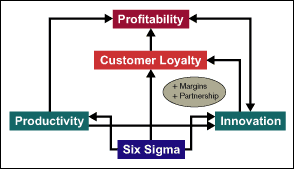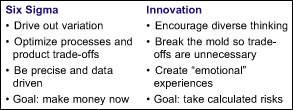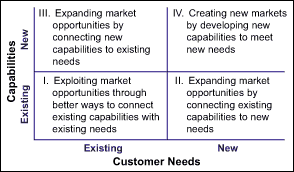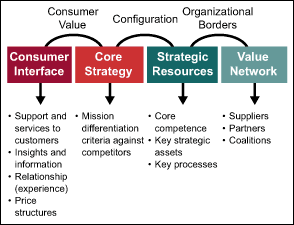
“Innovation is something new and contrary to established
customs, manners or rites.”
– Sir Francis Bacon (1561-1626)
Passion is one thing that both innovators and innovative companies share. Innovation, by definition, runs counter to conventional wisdom. To see a new idea become a reality, an individual or company has to have enough passion to overcome the obstacles. In fact, if an idea does not kick up serious resistance, it probably is not very innovative.
A discussion of the relationship between Six Sigma and innovation is a discussion of process and passion.
Complementary and Yet Opposite
Using the General Electric definition, Six Sigma is about “completely satisfying customer needs profitably.” More narrowly, it is about on-target performance with minimum variation. What is the relationship between Six Sigma and innovation? Are the two complementary or do they work in opposite directions? Actually, they are both complementary and opposite, and here is why.
From a practical business point of view, if a company is not able to deliver on the promises it makes to customers and the marketplace, the goodwill available for introducing an innovation is minimal. Why should a customer trust the company to deliver a breakthrough when it cannot get the basics right? By helping to engineer stable, capable processes and products that create customer loyalty, Six Sigma establishes the foundation upon which profitable growth can happen – through innovation (Figure 1).
As a result of eliminating costly variations in processes and products, Six Sigma also frees up resources that can be reinvested in innovation. The pharmaceutical industry offers a vivid example. Development costs for one drug range from $800 million to $1.2 billion. On average, companies in all industries spend between 3 and 15 percent on researching and developing new products and services. By improving operating and capital efficiency, Six Sigma helps fund innovation.
By making execution of a new idea more predictable, Six Sigma also helps to mitigate risk, which goes hand-in-hand with innovation. Countless great products have fallen flat not because of design issues, but because of the failure to hit the window in the market for introducing the product, or simply the inability to supply the product reliably.


By improving service and product reliability, freeing up resources and shoring up a company’s ability to execute the commercial aspects of innovation, Six Sigma is a strategic enabler of innovation. And yet, from a leadership point of view, the conflicting demands of Six Sigma and innovation could leave one feeling schizophrenic.
Look at the different requirements placed on a business leader by each, as shown in Figure 2.


Clearly, both Six Sigma and innovation are necessary for sustained business success. Focusing on process only, on efficiency and cost, is no guarantee for longevity. Innovation, which harnesses the energy of passion, is the engine for growth.
Four Levels of Innovation
More than invention, innovation is about novel ways of creating commercial value. A good working definition of innovation is:
People creating value through the introduction of new
ideas, practices and business models.
It is the perception that an idea is new that is the key. A technology used for many years in one market segment or for one application may be perceived as entirely new when introduced to another market segment. Global positioning systems, for example, used for years by the military, are suddenly innovative when introduced in civilian passenger vehicles. As depicted in Figure 3, it is the combination of capabilities and customer/user segments that defines the level of innovation.
Of course, level IV is everyone’s dream – to create new markets by changing the game.
Game-changing combinations of new capabilities that meet or create new market needs most often take place on the business rather than product level. Virgin’s brand services and products, Indesit’s Graffiti refrigerator and Apple Computer’s iPod line of music players are just a few examples of business successes that are bigger than simply a product innovation. All demonstrate the power of innovation in one or more key areas – customer interface, core strategy, strategic resources and the value network.
Customer Interface: Virgin, Zara and Graffiti
How a company gets in touch with customers or consumers is at the heart of customer interface. Customer interface is about the channels for giving and getting information, from online shops to physical stores to websites to trade fairs. What kind of experience does a company create for customers when they use its services? Customer interface is linked to the positioning of a brand.
Sir Richard Branson, chairman of the Virgin Group – the media, travel and entertainment companies all bearing the distinctive red Virgin brand name – wants “all customers to have a red experience.” By that he means, “be a maverick, challenge the rules. I want to be Robin Hood in every sector from airlines to record distribution.” He intends for his companies to create in their customers a sense of belonging based on their experiences with his brands.
Likewise, Spanish retailer Zara broke the traditional trade-off that customers either have a great in-store experience or they get discounted products and have a terrible in-store experience. Zara’s beautifully designed, upscale stores sell competitively priced merchandise. And the stock can be completely changed in 10 days.
A third example is Indesit’s line of Graffiti refrigerators. Indesit designed a refrigerator with a whiteboard surface for writing on. It uses existing capabilities to address the needs of a specific market segment – families – that uses the refrigerator in one of the home’s communication centers, the kitchen.
In each of the above instances, success is a result of a novel customer interface that augments the product in ways that are consistent with – and build – the brand.
Core Strategy: Virgin and Apple Computer
As Michel Porter, well-know author and Harvard business professor, points out, strategy is about differentiation. Virgin differentiates itself in the eyes of consumers as a David amongst industry Goliaths. The company openly states on its website that its focus is on “markets where the customer has been ripped off or under-served, where there is confusion and/or where the competition is complacent.”
Similarly, Apple’s iPod fits perfectly with company’s mission of giving power to the people through user-friendly technology. The iPod is really a form of ubiquitous computing. As Gary Hamel, strategy guru, notes, combining strategy with novel customer interfaces results in exceptional customer value.
Strategic Resources: Dell Computer and Honda
What does a company do distinctively better than others? What strategic resources give a company access to different markets, are welcomed by customers and are difficult for competitors to replicate in the short term? These resources could be the brand, people or channels of distribution.
Dell Computer is well known for leveraging order fulfillment capabilities, first out of necessity (i.e., start-up capital was only $1,000) and later as a core competence and strategic resource. Another example is Honda Motor Company, which is found in any market that requires compact engines – from cars to lawn mowers to portable electric generators. By combining strategic focus with distinctive competences and resources, these companies lead their markets with innovative business configurations.
Value Network: Apple Computer
Increasingly, businesses realize that they need to tap into external as well as internal sources of innovation for new ideas and creative ways to reach customers and users. That is where the value network is key – the suppliers, partners and coalitions that, when combined, extend the reach and value of a business.
By striking a deal with the major recording labels, for example, Apple Computer clearly augmented the value of its iPod by providing access to more than a million songs priced at 99 cents each. The content was unbundled from having to buy the entire CD, and re-bundled with the device in a novel way. Now, customers can listen to only their favorite tunes, wherever and whenever they like. With the iPod, Apple Computer combines strategic resources – such as the user-friendliness of the Apple line and the openness of the system it uses (an iPod can dialogue with virtually any other device) – with a value network, and in doing so, innovates by creating new organizational borders.
Conclusion: Value and Creativity
Innovation is about creating, capturing and delivering value and doing it with passion. Without reliable processes and Six Sigma, however, the risk is that innovations will remain an unfulfilled promise. Clearly, both reliability and creativity are needed for sustained success, though they place conflicting demands on business leaders.
Combining capabilities with customer and user needs, a company can innovate at various levels – while the “holy grail” remains developing new capabilities that create new markets. By combining the major elements of business innovation – customer interface, core strategy, strategic resources and a value network – in novel ways, organizations achieve innovations in customer value, business configuration and organizational borders. It is at this level that businesses today are innovating worldwide, and doing so in ways that are difficult for others to replicate.